1988 PONTIAC FIERO light
[x] Cancel search: lightPage 714 of 1825
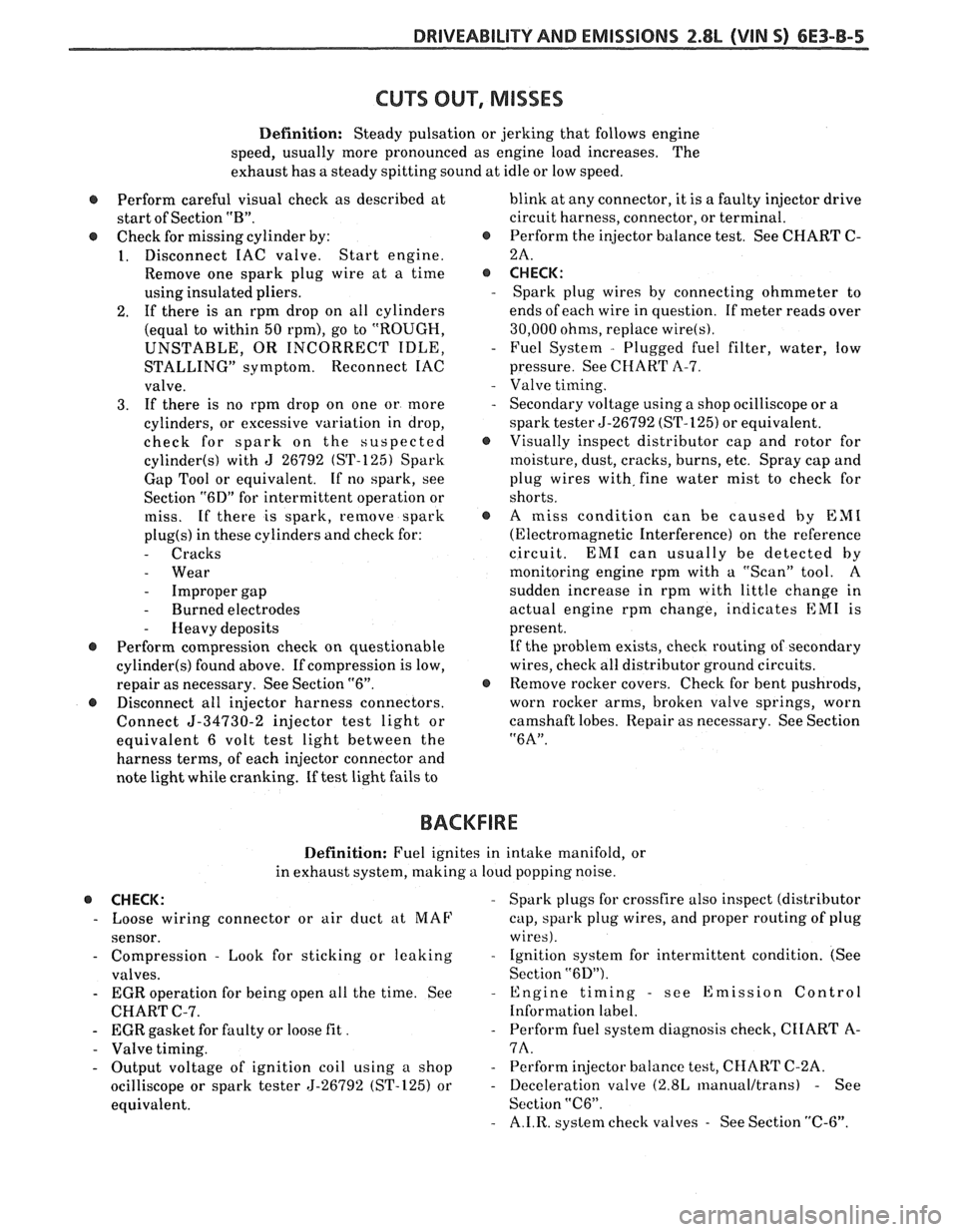
DWI\/EABILITV AND EMISSIONS 2.8L (VIN 5) 6E3-B-5
CU"T SUP, MISSES
Definition: Steady pulsation or jerking that follows engine
speed, usually more pronounced as engine load increases. The
exhaust has a steady spitting sound at idle or low speed.
@ Perform careful visual check as described at
start of Section
"B".
@ Check for missing cylinder by:
1. Disconnect IAC valve. Start engine.
Remove one spark plug wire at a time
using insulated pliers.
2. If there is an rpm drop on all cylinders
(equal to within
50 rpm), go to "ROUGH,
UNSTABLE, OR INCORRECT IDLE,
STALLING" symptom. Reconnect IAC
valve.
3. If
there is no rprn drop on one or more
cylinders, or excessive variation in drop,
check for spark on the suspected
cylinder(s) with J 26792 (ST-125) Spark
Gap Tool or equivalent.
If no spark, see
Section
"6D" for intermittent operation or
miss. If there is spark, remove spark
plug(s) in these cylinders and check for:
- Cracks
- Wear
- Improper gap
- Burned electrodes
- Iieavy deposits
@ Perform compression check on questionable
cylinder(s) found above. If compression is low,
repair as necessary. See Section
"6".
@ Disconnect all injector harness connectors.
Connect
5-34730-2 injector test light or
equivalent 6 volt test light between the
harness terms, of each injector connector and
note light while cranking. If test light fails to blink
at any connector, it is a faulty injector drive
circuit harness, connector, or terminal.
@ Perform the injector balance test. See CHART C-
2A.
s CHECK:
- Spark plug wires by connecting ohmmeter to
ends of each wire in question. If meter reads over
30,000 ohms, replace wire(s1.
- Fuel System - Plugged fuel filter, water, low
pressure. See
CHART A-7.
- Valve timing.
- Secondary voltage using a shop ocilliscope or a
spark tester 5-26792 (ST-125) or equivalent.
@ Visually inspect distributor cap and rotor for
moisture, dust, cracks, burns, etc. Spray cap and
plug wires with, fine water mist to check for
shorts.
@ A miss condition can be caused by EM1
(Electromagnetic Interference) on the reference
circuit.
EM1 can usually be detected by
monitoring engine rpm with a "Scan" tool. A
sudden increase in rpm with little change in
actual engine rpm change, indicates
EM1 is
present. If the problem exists, check routing of secondary
wires, check all distributor ground circuits.
@ Remove rocker covers. Check for bent pushrods,
worn rocker arms, broken valve springs, worn
camshaft lobes. Repair as necessary. See Section
"6A".
BACKFIRE
Definition: Fuel ignites in intake manifold, or
in exhaust system, making a loud popping noise.
CHECK:
- Loose wiring connector or air duct at MAF
sensor.
- Compression - Look for sticking or leaking
valves.
- EGR operation for being open all the time. See
CHART C-7.
- EGR gasket for faulty or loose fit .
- Valve timing.
- Output voltage of ignition coil using a shop
ocilliscope or spark tester 5-26792 (ST-125) or
equivalent.
- Spark plugs for crossfire also inspect (distributor
cap, spark plug wires, and proper routing of plug
wires).
- Ignition system for intermittent condition. (See
Section
"6D").
- Engine timing - see Emission Control
Information label.
- Perform fuel system diagnosis check, CIIART A-
7A.
- Perform injector balance test, CHART C-2A.
- Deceleration valve (2.8L ~nanualltrans) - See
Section
"C6".
- A.I.R. system check valves - See Section "C-6".
Page 719 of 1825

6E3-C-1 2.8L (VIN S) DRIVEABILITY AND EMISSIONS
COMPONENT SYSTEMS
Section C provides information on the following:
@ General description of components and systems .
e On-vehicle service .
@ Part names and group numbers .
@ Diagnostic charts . These include a functional check of the system as well as diagnosis of any problem
found in the functional check
.
For locations of components. wiring diagrams and ECM Terminal End View refer to the front of the A Sections of
the engine being diagnosed
.
Following are the sub-section identification and the system covered:
Electronic Control Module (ECM) and Sensors
........................... Page C1-I
Fuel Control System ............................................... Page C2-1
Evaporative Emission Control (EECS) System ............................ Page C3-1
Ignition SystemIEST ............................................... Page C4-1
Air Injection Reaction (A.I.R.) System Manual Transmission Only .............. Page C6-1
Exhaust Gas Recirculation (EGR) System ................................ Page C7-1
Transmission Converter Clutch (TCC) System and Manual Transmission Shift Light Page C8-1
ECM Controlled Air Conditioning .................................... Page C10-I
Cooling Fan Control ............................................... Page C12-1
Positive Crankcase Ventilation (PCV) .................................. Page C13-1
DIAGNOSTIC CHARTS
The Diagnostic Charts for each system are found after the on-car service and parts information at the back of
each section
. Following are the charts found in this section .
@ Chart C-I
@ Chart C-1A
e ChartC-1E
@ Chart C-2A
e Chart C-2C
@ Chart C-3
@ Chart C-4A
@ Chart C-6
@ Chart C-7
@ Chart C-8
@ Chart C-8
@ Chart C-10
@ Chart C-12
@ Chart C-12 ECM
QDR Check ........................................... Page C1-10
Park
Neutral Switch ........................................ Page C1-12
Power Steering Pressure Switch Check .......................... Page C1-14
Injector Balance Test ....................................... Page C2-18
Idle Air Control ........................................... Page C2-20
Canister Purge Valve Check .................................. Page C3-4
Ignition System Check ...................................... Page C4-4
Electric Control (Divert) . (Manual Transmission) .................. Page C6-6
Exhaust Gas Recirculation Check .............................. Page C7-6
Automatic Transmission Converter Clutch (TCC) . 1 of 2 ............. Page C8-2
Automatic Transmission Converter Clutch (TCC) . 2 of 2 ............. Page C8-4
NC Clutch Control ......................................... Page C10-2
. ............. ............... Cooling Fan Control Circuit 1 of 2 Page C12-2
. ............................. Cooling Fan Control Circuit 2 of 2 Page C12-4
Page 720 of 1825
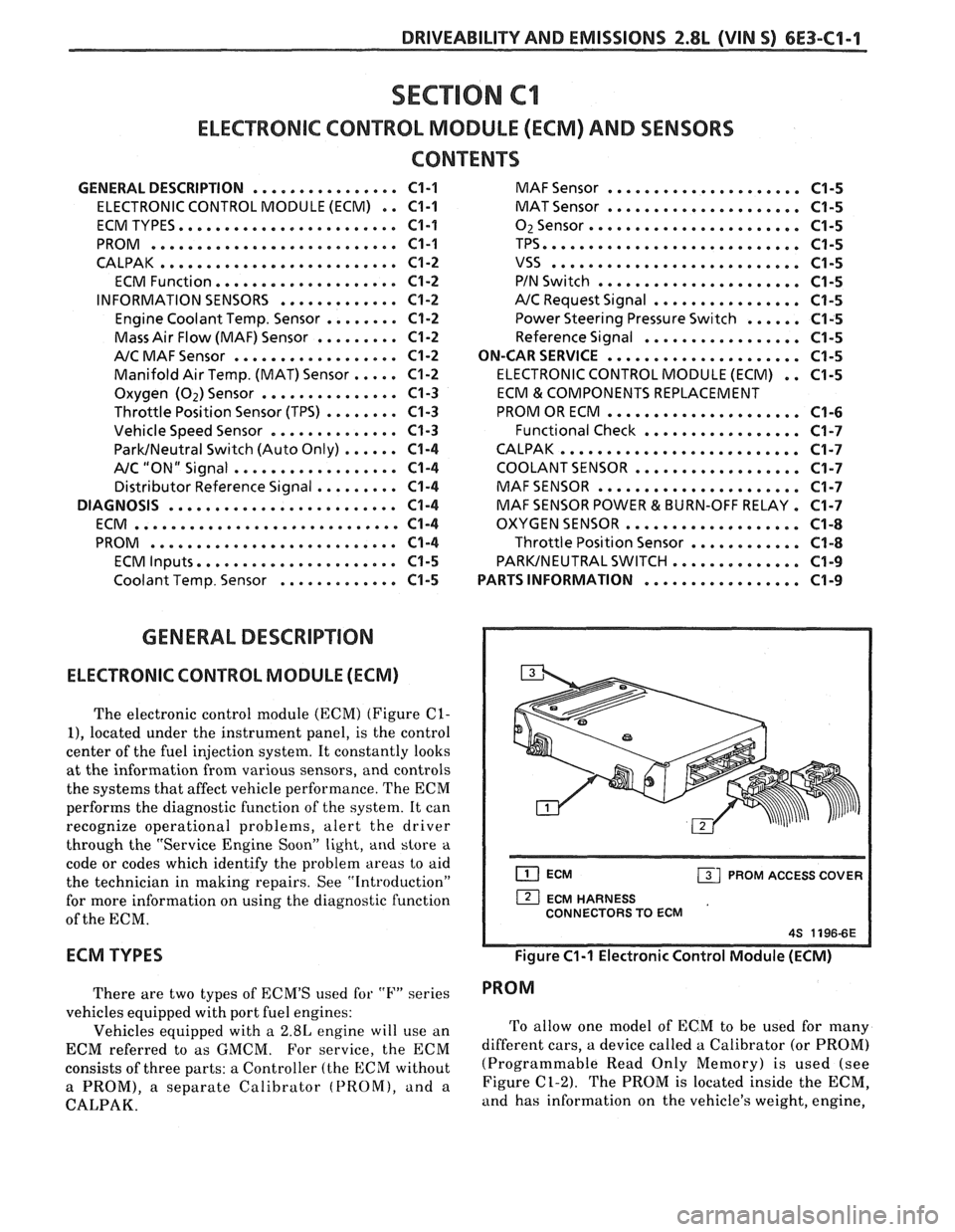
DRIVEABILITY AND EMISSIONS 2.8L WIN S) 6E3-C1-1
SECTION C1
ELECTRONIC CONTROL MODULE (ECM) AND SENSORS
CONTENTS
GENERAL DESCRIPTION ................ C1-1 MAF Sensor ..................... C1-5
ELECTRONIC CONTROL MODULE (ECM) , . C1-1 MAT Sensor ..................... C1-5
ECMTYPES.. ...................... C1-I O2 Sensor ....................... C1-5
PROM ........................... C1-1 TPS............................ C1-5
CALPAK .......................... C1-2 VSS ........................... C1-5
ECM Function..
.................. C1-2 PIN Switch ...................... C1-5
INFORMATION SENSORS ............. C1-2 A/C Request Signal ................ C1-5
........ Engine Coolant Temp. Sensor C1-2 Power Steering Pressure Switch ...... C1-5
Mass Air Flow (MAF) Sensor ......... C1-2 Reference Signal ................. C1-5
A/C MAF Sensor .................. C1-2 ON-CAR SERVICE ..................... C1-5
..... Manifold Air Temp. (MAT) Sensor C1-2 ELECTRONIC CONTROL MODULE (ECM) . . C1-5
Oxygen (Oz) Sensor ............... C1-3 ECM & COMPONENTS REPLACEMENT
........ Throttle Position Sensor (TPS) C1-3 PROMORECM ..................... C1-6
Vehicle Speed Sensor
.............. C1-3 Functional Check ................. C1-7
...... ParkINeutral Switch (Auto Only) C1-4 CALPAK.......................... C1-7
AIC "ON" Signal .................. C1-4 COOLANTSENSOR .................. C1-7
Distributor Reference Signal
......... C1-4 MAFSENSOR ...................... C1-7
DIAGNOSIS ......................... C1-4 MAF SENSOR POWER & BURN-OFF RELAY. C1-7
ECM .......e.........e........... C1-4 OXYGENSENSOR ................... C1-8
PROM ........................... C1-4 Throttle Position Sensor ............ C1-8
ECM Inputs..
.................... C1-5 PARKJNEUTRALSWITCH .............. C1-9
Coolant Temp. Sensor ............. C1-5 PARTS INFORMATION ................. C1-9
GENERAL DESCRIPTION
ELECTRONIC CONTROL MODULE (ECM)
The electronic control module (ECM) (Figure C1-
I), located under the instrument panel, is the control
center of the fuel injection system. It constantly looks
at the information from various sensors, and controls
the systems that affect vehicle performance. The ECM
performs the diagnostic function of the system. It can
recognize operational problems, alert the driver
through the "Service Engine Soon"
light, and store a
code or codes which identify the problem areas to aid
the technician in making repairs. See "Introduction"
for more information on using the diagnostic function
of the ECM.
ECM TYPES
There are two types of ECM'S used for "I?" series
vehicles equipped with port fuel engines:
Vehicles equipped with a
2.8L engine will use an
ECM referred to as GMCM. For
service, the ECM
consists of three parts: a Controller (the ECM without
a PROM), a separate Calibrator (PROM), and a
CALPAK.
ECM PROM ACCESS COVER I
1 ECM HARNESS
CONNECTORS TO ECM
Figure C1-1 Electronic Control Module (ECM)
PROM
To allow one model of ECM to be used for many
different cars, a device called a Calibrator (or PROM)
(Programmable Read Only Memory) is used (see
Figure
C1-2). The PROM is located inside the ECM,
and has information on the vehicle's weight, engine,
Page 721 of 1825
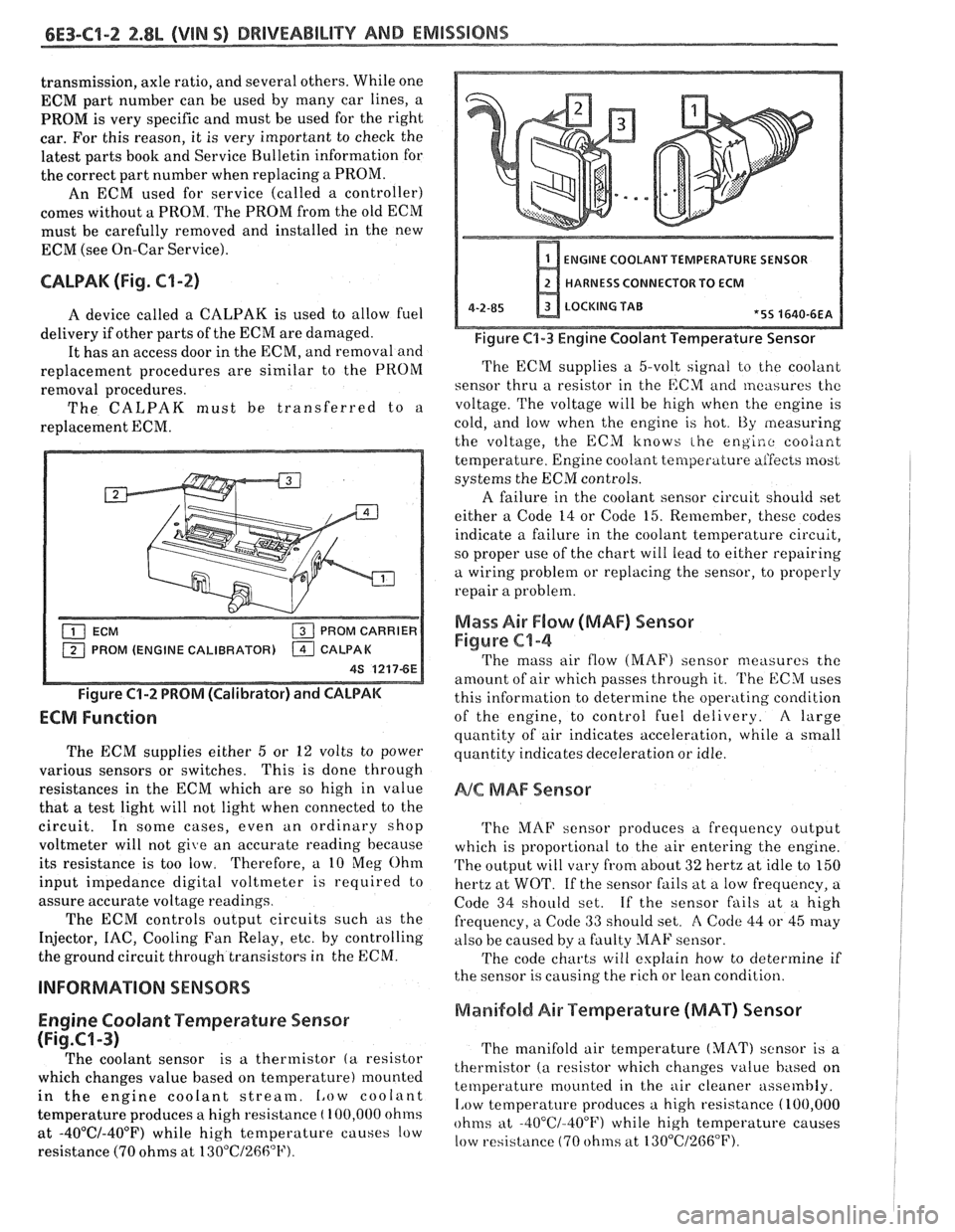
6E3-C1-2 2.8L (VIN S) DRIVEABILITY AND EMISSIONS
transmission, axle ratio, and several others. While one
ECM part number can be used by many car lines, a
PROM is very specific and must be used for the right
car. For this reason, it is very important to check the
latest parts book and Service Bulletin information for
the correct part number when replacing a PROM.
An ECM used for service (called a controller)
comes without a PROM. The PROM from the old ECM
must be carefully removed and installed in the new
ECM (see On-Car Service).
CALPAK (Fig. C1-2)
A device called a CALPAK is used to allow fuel
delivery if other parts of the ECM are damaged.
It has an access door in the ECM, and removal and
replacement procedures are similar to the PROM
removal procedures.
The CALPAK must be transferred to a
replacement ECM.
M (ENGINE CALIBRATOR)
Figure C1-2 PROM (Calibrator) and CALPAK
ECM Function
The ECM supplies either 5 or 12 volts to power
various sensors or switches. This is done through
resistances in the ECM which are so high in value
that
a test light will not light when connected to the
circuit. In some cases, even an ordinary shop
voltmeter will not give an accurate reading because
its resistance is too low. Therefore, a 10
Meg Ohm
input impedance digital voltmeter is required to
assure accurate voltage readings.
The ECM controls output circuits such as the
Injector, IAC, Cooling Fan Relay, etc. by controlling
the ground circuit
thr0ug.h transistors in the ECM.
Engine Coolant Temperature Sensor
(Fig.CI-3)
The coolant sensor is a thermistor (a resistor
which changes value based on temperature) mounted
in the engine coolant stream.
Low coolant
temperature produces a high resistance
( 100,000 ohms
at -40°C/-40°F) while high temperature causes low
resistance (70 ohms at
130"C/26fi°F).
ENGINE COOLANT TEMPERATURE SENIOR
HARNESS CONNECTOR TO ECM
4-2-85 LOCKING TAB *5S 4640-6EA
Figure C1-3 Engine Coolant Temperature Sensor
The ECM supplies a 5-volt signal to the coolant
sensor thru a resistor in the ECM
and measures thc
voltage. The voltage will be high when the engine is
cold, and
low when the engine is hot. t3y measuring
the voltage, the ECM knows
the engiao coo/ant
temperature. Engine coolant temperature aifeces most
systems the ECM controls.
A failure
in the coolant sensor circuit should set
either a Code 14 or Code 15. Remember, these codes
indicate a failure in the coolant temperature circuit,
so proper use of the chart will
lead to either repairing
a wiring problem or replacing the sensor, to properly
repair a problem.
Mass Air F10w (MAF) Sensor
Figure C1-4
The mass air flow (MAF) sensor measures the
amount of air which passes through it.
'I'he ECM uses
this information to determine the operating condition
of the engine, to control
fuel delivery. A large
quantity of air indicates acceleration, while a small
quantity indicates deceleration or idle.
NC MAF Sensor
'I'he MAF sensor produces a frequency output
which is proportional to the air entering the en,'
alne.
The output will vary from about 32 hertz at idle to 150
hertz at WOT. If the sensor fails at a low frequency, a
Code 34 should set. If the sensor fails at a high
frequency, a
Code 33 should set. A Code 44 or 45 may
also be caused by a faulty
MAF sensor.
'I'he code charts will explain how to determine if
the sensor is causing the rich or lean condition.
Manifold Air Temperature (MAT) Sensor
The manifold air temperature (MAT) sensor is a
thermistor
(a resistor which changes value based on
temperature mounted in the
air cleaner assembly.
1,ow temperature produces a high resistance (100,000
ohms at -40°C/-400F) while high temperature causes
low resistance (70 ohms at
130"C/2G6"F).
Page 722 of 1825

The ECM supplies a 5-volt signal to the sensor
thru
a resistor in the ECM and measures the voltage.
The voltage will be high when the manifold air is cold,
and low when the air is hot. By measuring the
voltage, the ECM knows the manifold air
temperature.
The
2.8L uses the signal to slightly retard the
timing during high ambient air temperatures and to
help compensate the MAF sensor based on air
temperature.
A failure in the MAT sensor circuit should set
either a Code
23 or Code 25.
Oxygen (02) Sensor (Fig. C1-4)
The exhaust oxygen sensor (02) is mounted in the
exhaust system where it can monitor the oxygen
content of the exhaust gas stream. The oxygen content
in the exhaust reacts with the sensor to produce a
voltage output. This voltage ranges from
approximately
.1 volt (high 02 - lean mixture) to .9
volts (low 02 - rich mixture). This voltage can be
measured with a digital voltmeter having at least
10
megohms input impedance. Use of standard shop type
voltmeters will result in very inaccurate readings.
By monitoring the voltage output of the
02 sensor,
the ECM will know what fuel mixture command to
give to the Injector (lean mixture-low
02 voltage = rich
command, rich mixture-high
02 voltage = lean
command). The
02 sensor, if open, should set a Code 13. A low
voltage in the sensor circuit should set a Code 44. A
high voltage in the circuit should set a Code 45. Codes
44 and 45 could also be set
as a result of fuel system
problems. See code charts.
Throttle Position Sensor (PPS) (Fig. C4-5)
The throttle position sensor (TPS) is connected to
the throttle shaft on the throttle body. It is
a
potentiometer with one end connected to 5 volts from
the ECM and the other to ECM ground.
A third wire
is connected to the ECM to measure the voltage from
the TPS. As the throttle valve angle is changed
(accelerator pedal moved), the output of the TPS also
changes. At a closed throttle position, the output of
the TPS is low (approximately
.5 volts). As the
throttle valve opens, the output increases so that, at
wide open throttle, the output voltage should be
approximately 5 volts.
By monitoring the output voltage from the TPS,
the ECM can determine fuel delivery based on throttle
valve angle (driver demand). A
broken or loose TPS
can cause intermittent bursts of fuel from the injector,
and an unstable idle, because the ECM thinks the
throttle is moving.
A problem in any of the TPS
circuits will set either
a Code 21 or 22. Once a trouble
code is set, the ECM will use an artificial default value
for TPS, and some vehicle performance will return.
See "On-Car Service" for replacement or
adjustment of TPS.
10 THROTTLE BODY ASSEMBLY
20 THROTTLE POSITION SENSOR (TPS)
21 TPS ATTACHING SCREW
22 TPS RETAINER 55 1638-6E
Figure C1-5 Throttle Position Sensor
Vehicle Speed Sensor
The vehicle speed sensor (VSS) sends a pulsing
voltage signal to the ECM, which the ECM converts to
miles per hour. This sensor mainly controls the
operation of the TCC system. See "TCC System" for
more information.
Page 723 of 1825
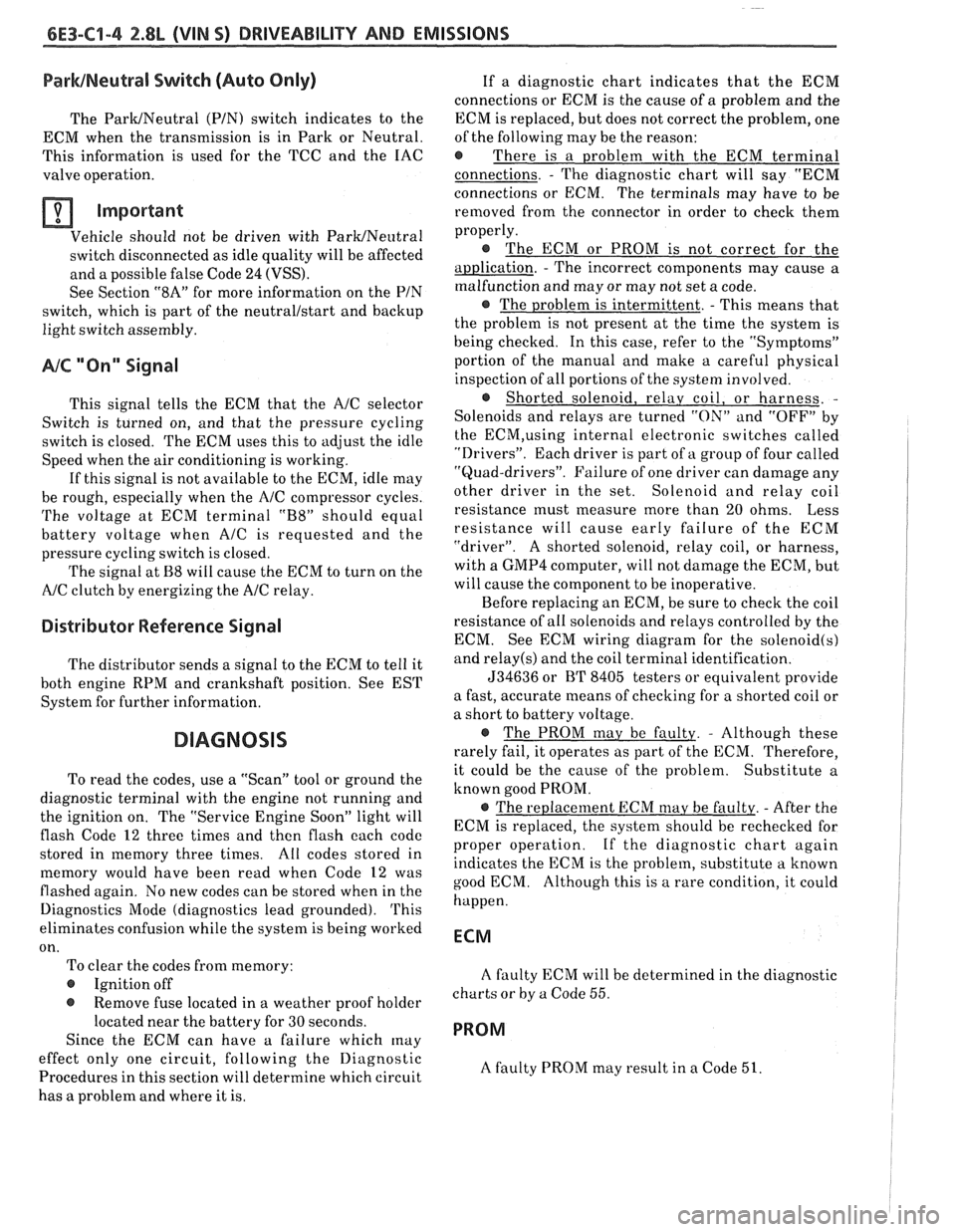
6E3-Cl-4 2.8L (VIN S) DRIVEABILITY AND EMISSIONS
BarWNeutral Switch (Auto Only)
The ParWNeutral (PIN) switch indicates to the
ECM when the transmission is in Park or Neutral.
This information is used for the TCC and the IAC
valve operation.
Important
Vehicle should not be driven with ParWNeutral
switch disconnected as idle quality will be affected
and a possible false Code
24 (VSS).
See Section "$A" for more information on the PIN
switch, which is part of the neutrallstart and backup
light switch assembly.
NC '"n" Signal
This signal tells the ECM that the A/C selector
Switch is turned on, and that the pressure cycling
switch is closed. The ECM uses this to adjust the idle
Speed when the air conditioning is working.
If this signal is not available to the ECM, idle may
be rough, especially when the
A/C compressor cycles.
The voltage at ECM terminal "B8" should equal
battery voltage when
AIC is requested and the
pressure cycling switch is closed.
The signal at
B8 will cause the ECM to turn on the
A/C clutch by energizing the A/C relay.
Distributor Reference Signal
The distributor sends a signal to the ECM to tell it
both engine RPM and crankshaft position. See EST
System for further information.
To read the codes, use a "Scan" tool or ground the
diagnostic terminal with the engine not running and
the ignition on. The "Service Engine Soon" light will
flash Code 12 three times and
then flash each code
stored in memory three times. All codes stored in
memory would have been read when Code 12 was
flashed again. No new codes can be stored when in the
Diagnostics Mode (diagnostics lead grounded).
This
eliminates confusion while the system is being worked
on. To clear the codes from memory:
@ Ignition off
@ Remove fuse located in a weather proof holder
located near the battery for 30 seconds.
Since the ECM can have
a failure which may
effect only one circuit, following the Diagnostic
Procedures in this section will determine which circuit
has a problem and where it is. If
a diagnostic chart indicates that the ECM
connections or ECM is the cause of
a problem and the
ECM is replaced, but does not correct the problem, one
of the following may be the reason:
€9
connections. - The diagnostic chart will say "ECM
connections or ECM. The terminals may have to be
removed from the connector in order to check them
properly.
@ The ECM or PROM is not correct for the
application.
- The incorrect components may cause a
malfunction and may or may not set a code.
@ The problem is intermittent. - This means that
the problem is not present at the time the system is
being checked. In this case, refer to the "Symptoms"
portion of the manual and make a careful physical
inspection of all portions of the system involved.
@ Shorted solenoid, relay coil, or harness. -
Solenoids and relays are turned "ON" and "OFF" by
the
ECM,using internal electronic switches called
"Drivers". Each driver is part of
a group of four called
"Quad-drivers". Failure of one driver can damage any
other driver in the set.
Solelloid and relay coil
resistance must measure more than 20 ohms. Less
resistance will cause early failure of the ECM
"driver". A shorted solenoid, relay coil, or harness,
with a GMP4 computer, will not damage the ECM, but
will cause the component to be inoperative.
Before replacing an ECM, be sure to check the coil
resistance of all solenoids and relays controlled by the
ECM. See ECM wiring diagram for the
solenoid(s)
and relay(s) and the coil terminal identification.
534636 or BT 8405 testers or equivalent provide
a fast, accurate means of checking for a shorted coil or
a short to battery voltage.
@ The PROM may be faulty. - Although these
rarely fail, it operates as part of the ECM. Therefore,
it could be the cause of the problem. Substitute a
known good PROM.
@ The replacement ECM may be faulty. - After the
ECM is replaced, the system should be rechecked for
proper operation. If the diagnostic chart again
indicates the ECM is the problem, substitute
a known
good ECM. Although this is a rare condition, it could
happen.
ECM
A faulty ECM will be determined in the diagnostic
charts or
by a Code 55.
PROM
A faulty PROM may result in a Code 51.
Page 726 of 1825
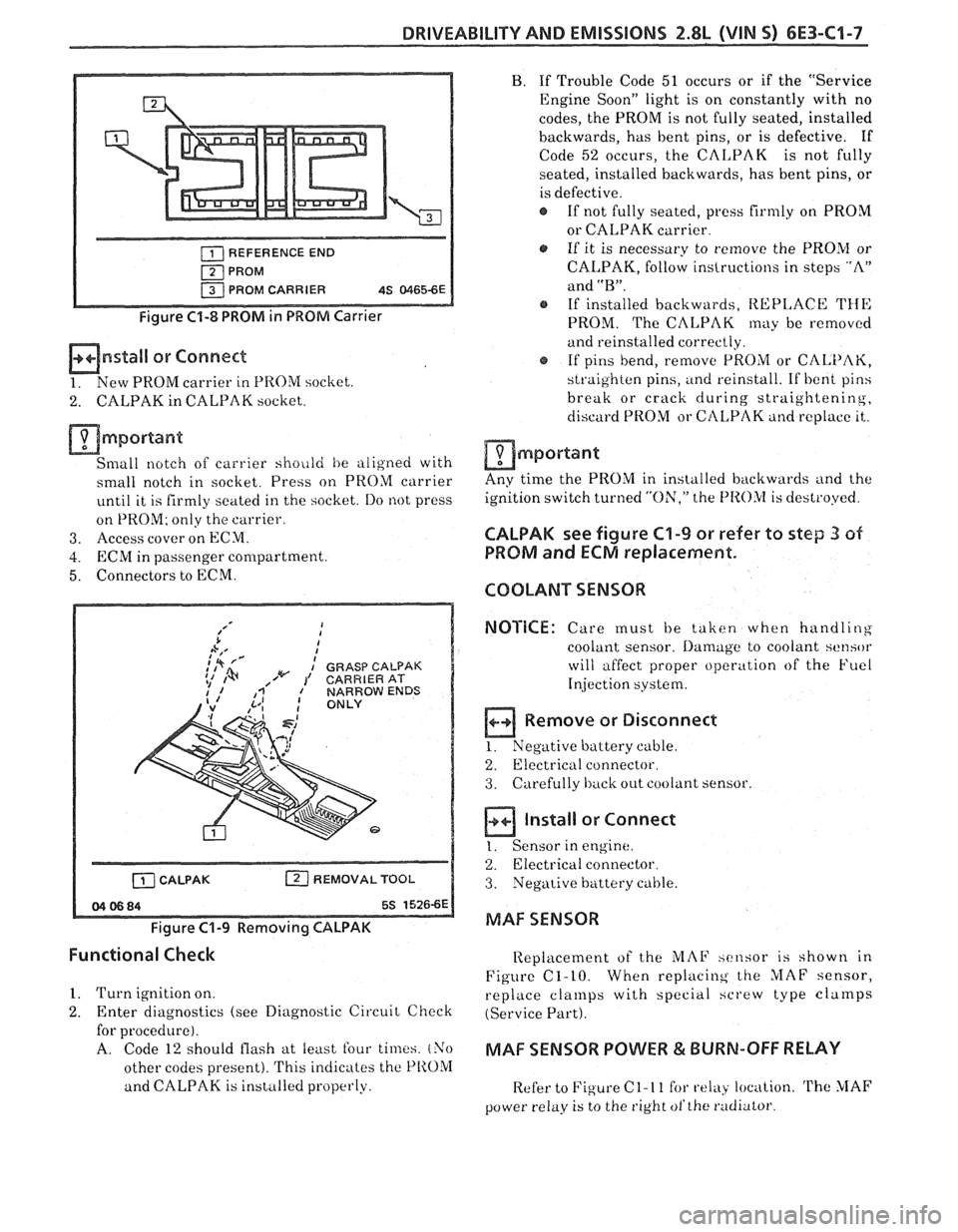
DRIVEABILITY AND EMISSIONS 2.8L (VIN S) 6E3-C1-7
REFERENCE END
PROM PROM CARRIER
4S 81165-6E
Figure C1-8 PROM in PROM Carrier
mnstall or Connect
1. New PROM carrier in PROM socliet.
2. CALPAK in CALPAK socket.
mmportant
Small notch of carrier shoiild he aligned with
small notch in socket. Press on PROM carrier
until it is firmly seated in the socket. Do not press
on PROM; only the carrier.
3. Access cover on ECM.
4. ECRil in passenger compartment.
5. Connectors to ECM.
b A,' I
;,* fd I
: GRASP CALPAK 1% ,/w 1' CARRIERAT
[ZJ REMOVAL TOOL
Figure C1-9 Removing CALPAK
B. If Trouble Code 51 occurs or if the "Service
Engine Soon" light is on constantly with no
codes, the PROM is not fully seated, installed
backwards, has bent pins, or is defective. If
Code
52 occurs, the CALPAK is not fully
seated, installed backwards, has bent pins, or
is defective.
If not fully seated,
press firmly on PROM
or CALPAK carrier
a, If it is necessary to remove the PROM or
CALPAK, follow instructions in steps "A"
and
"B".
@ If installed backwards, REPLACE THE
PROM. The CALPAK may be removed
and reinstalled correctly.
@ If pins bend, remove PROM or CALPAK,
straighten pins, and reinstall. If
bent pins
break or crack during
straightening,
discard PROM or CtILPAK and replace it,.
am port ant
Any time the PROM in installed backwards and the
ignition switch turned
"ON," the f'I
PROM and ECM replacement.
COOLANT SENSOR
NOTICE:
Care must be taken when handling
coolant sensor.
Damage to coolant sensor
will affect proper operation of the Fuel
Injection
system.
B Remove or Disconnect
1. Negative buttery cable.
2.
Electricril connector.
3. Carefully back out coolant sensor.
a ln,aIl
1. Sensor in
or Connect
engine.
2. Electrical connector.
3. Negative battery cable.
MAF SENSOR
Functional Check
Replacement of the iL'IAF xcnsor is shown in
Figure C1-10. When
replacing the MAF sensor,
1. Turn ignition on.
replace cla~llps with special hcrew type cla~rlps
2. Enter diagnostics (see Diagnostic Circuit Check (Service Part).
for procedure).
A. Code 12 should flash at least four times. (Yo MAF SENSOR POWER & BURN-OFF RELAY
other codes present). This indicates the PIIOM
and CALPAK is installed properly.
Refer to Figure C 1- 1 1 for relay location. 'rhe MAF
power relay is to the right ofthe radiator
Page 729 of 1825
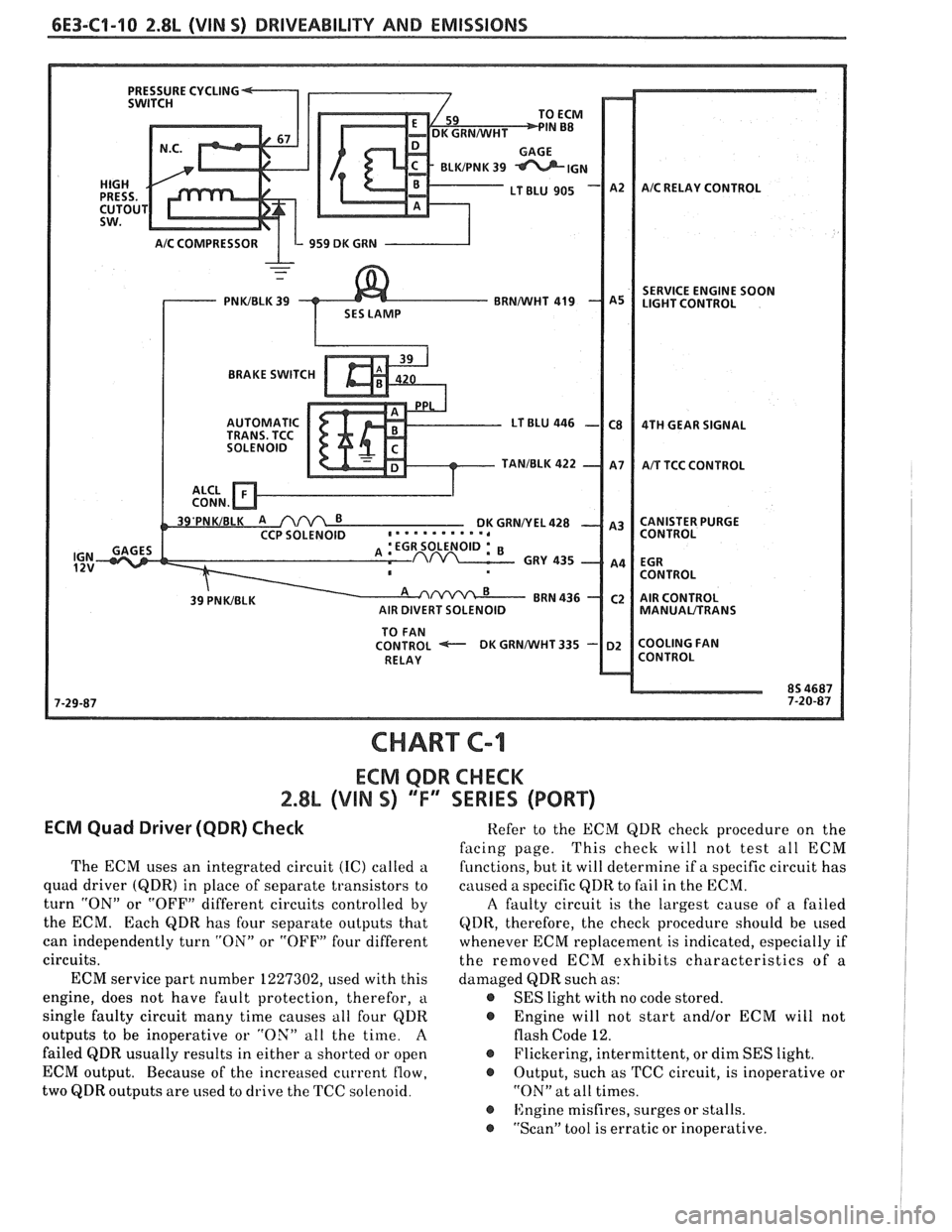
6E3-C1-10 2.8L (VIN 5) DRIVEABILITY AND EMISSIONS
- 959 DK GRN
BRAKE SWITCH
MANUALTRANS
TO FAN
CONTROL +-- DK GRNMIHT335 - COOLING FAN
RELAY
CHART C-I
ECM QDR CHECK
2.8% (VIN S) 'TI' SERIES (PORT)
ECM Quad Driwer (QDR) Check
The ECM uses an integrated circuit (IC) called a
quad driver
(QDR) in place of separate transistors to
turn "ON" or "OFF" different circuits controlled by
the ECM. Each
QDR has four separate outputs that
can independently turn "ON" or "OFF" four different
circuits.
ECM service part number 1227302, used with this
engine, does not have fault protection, therefor,
a
single faulty circuit many time causes all four QDR
outputs to be inoperative or "OX" all the time.
A
failed QDR usually results in either a shorted or open
ECM output. Because of the increased current
flow,
two QDR outputs are used to drive the TCC solenoid. Refer
to the ECM QDR check procedure on the
facing page. This
check will not test all ECM
functions, but it will determine if a specific circuit has
caused a specific
QDR to fail in the ECM.
A faulty circuit is the largest cause of a failed
QDR, therefore, the check procedure should be used
whenever ECM replacement is indicated, especially if
the removed ECM exhibits characteristics of a
damaged QDR such as:
@ SES light with no code stored.
@ Engine will not start and/or ECM will not
flash Code 12.
@ Flickering, intermittent, or dim SES light.
@ Output, such as TCC circuit, is inoperative or
"ON" at all times.
@ ISngine misfires, surges or stalls.
@ "Scan" tool is erratic or inoperative.